Blackmagic goes big with its new flagship digital cinema camera, the Blackmagic URSA Cine 12K LF. For the uninitiated, LF stands for large format. Surrounding the full frame 12K sensor is quite a bit of tech meant to streamline the process of getting video into the hands of editors and make shooting with a team easier. The URSA Cine is full of Blackmagic DNA and is also a surprising step forward for the Australian company.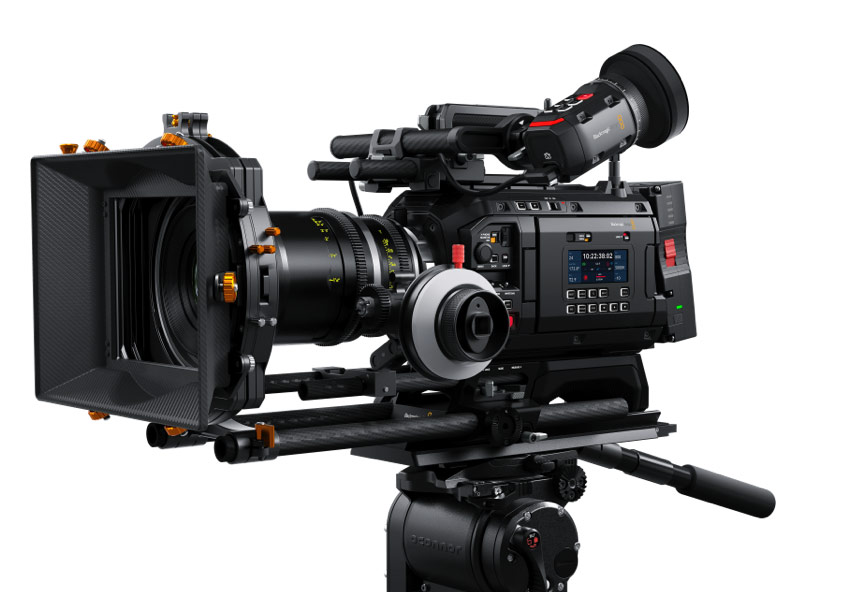
The Blackmagic URSA Cine 12K LF is purpose-built to serve professionals while trying to stay affordable. Some may see the USD 15,000 price tag and think it is expensive for a digital cinema camera. Here, you get more than just a sensor box and lens mount. With the URSA Cine, you have much more than a 12K camera.
According to Blackmagic Design, the URSA Cine was designed to remove all obstacles to getting pixels off the camera and into the editor’s hand as the production shoots. It is fair to say Blackmagic decided to make the best digital cinema camera they could make.
12K Large Format Sensor
Let’s start with the foundation of the Blackmagic URSA Cine 12K LF, which is the 12K full-frame sensor of their own design. The full frame 12K sensor measures close to 36mm x 24mm and boasts 16 stops of dynamic range. Gen 5 color is the current color profile for the 12K LF and a new DaVinci Resolve update will be released to support the URSA Cine.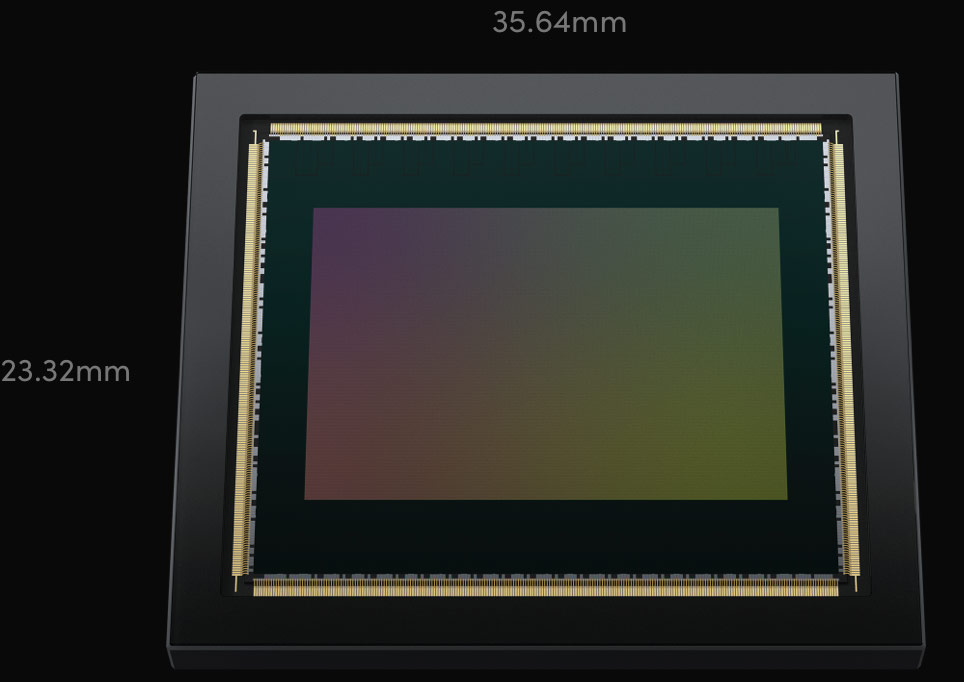
This camera does not have a dual-native ISO, which Blackmagic claims would result in a loss of dynamic range, which they see as critical to the success of the URSA Cine. I’m definitely down for 16 stops of dynamic range, and I believe the market for the URSA Cine may feel the same.
The base ISO is 800, and the highest ISO is 3200 for now. Blackmagic also mentioned that this 12K LF sensor has larger photosites, making it more light-sensitive.
The 12K resolution sounds huge, but Blackmagic has done something pretty incredible with its 12K sensors. Like the original 12K Super35-sized sensor, this new 12K full-frame version has the same color filter array. This means users can choose one of many resolutions and still retain the full sensor for the recording area. In other cameras, when one selects a lower resolution, those other sensors crop in to match that resolution choice. Not with Blackmagic’s 12K sensors, you get the whole sensor whether you choose 12K, 8K, or 4K.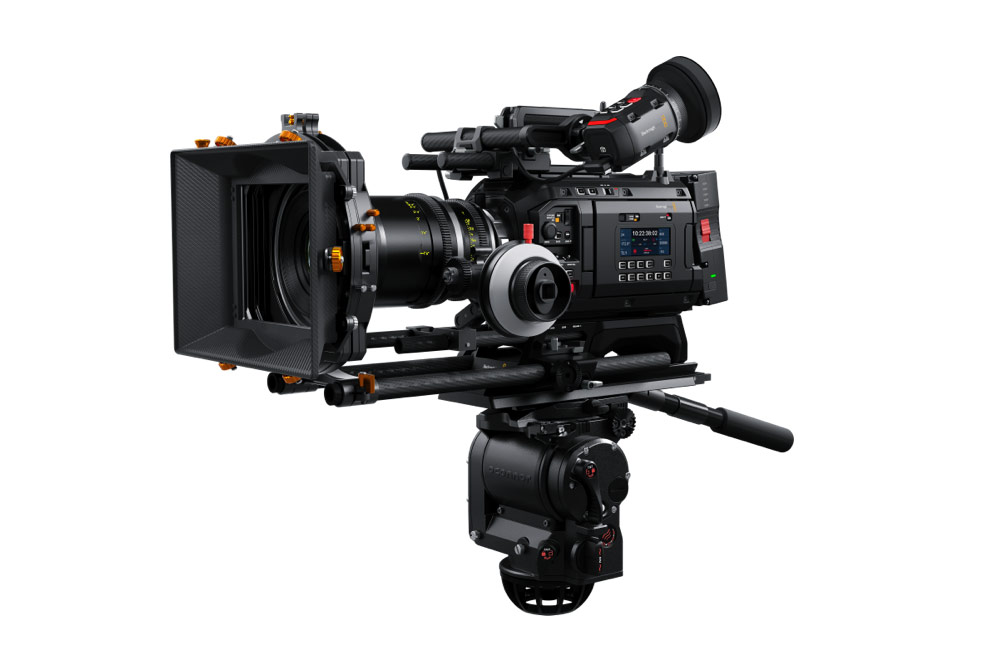
Built-In Filters
The Blackmagic URSA Cine 12K LF features a built-in optical low pass filter on the sensor. The camera has built-in IRND of 2, 4, and 6 stops. In a change from a rolling physical knob, one turns for ND filter selection, the URSA Cine uses two buttons on the top left side of the camera. Those buttons are the “+” or “-” buttons on the camera operator’s side for easy access. This also means that the ND’s can be controlled remotely.
Blackmagic URSA Cine 12K LF Lens Mounts
Blackmagic designed new mounting bolts for the URSA Cine’s lens mounts. Currently, the camera will ship with a PL mount and a locking EF mount. In the future, an LPL mount will be available. The addition of the LPL mount will be Blackmagic’s first time offering the LPL mount to users. Another important thing to note about the new lens mount is that the mount holds the shims in the mount.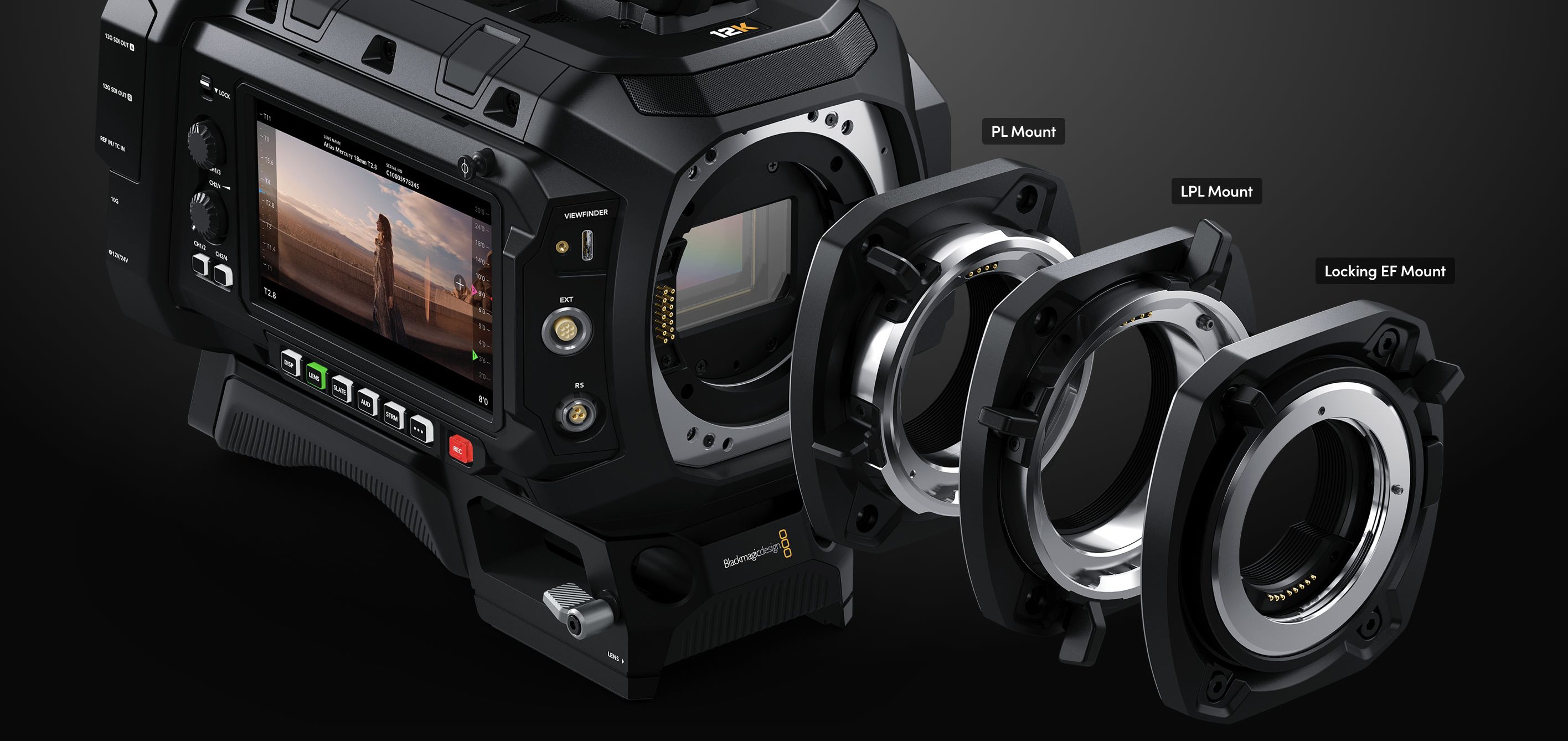
Recording Formats
Recording format highlights for the URSA Cine are 12K at 3:2 with frame rates up to 80fps, 12K at 17×9 with framerates up to 100fps, 12K at 2.4:1 with frame rates up to 120fps, and 8K at 2.4:1 with frame rates up to 224fps. These are the highlights that stick out for me. Like the original URSA Mini Pro 12K camera, I bet the Blackmagic URSA Cine 12K LF will have all the 8K and 4K options one needs.
Blackmagic also has a dedicated 9K S35 mm-specific mode. This is a Super35mm crop in of the 12K sensor and will allow those who want to shoot S35mm 4-perf, 3-perf, and 2-perf to match a 35mm film aesthetic better.
With anamorphic, I have written in my notes that they have all the different flavors one may want when shooting anamorphic. This includes 1.3, 1.5, 1.6, 1.66, 1.8 and 2x monitoring de-squeeze available in all record formats.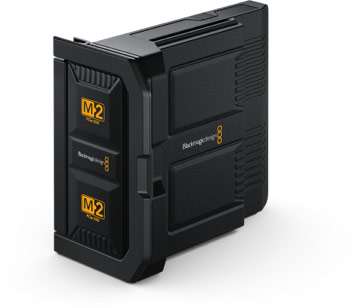
Blackmagic URSA Cine 12K LF Media
Where, oh, where to store all the 12K 80fps footage? In a cue to knowing the obvious hang-up to shooting 12K, Blackmagic has redesigned the whole media module on the Blackmagic URSA Cine 12K LF. The idea around the media storage solution by Blackmagic is to have an absolute ton of it in-camera.
Blackmagic created a whole media module that stores 8TB of storage, with a larger 16TB version to be released later. The entire media module comes out just like any other media solution for a camera.
These Blackmagic dedicated media modules will cost around $1,600 to $1,800 per 8TB of media. If that price makes you wrench, go and price our 8TB of CFExpress cards. You will quickly see that the price for 8TB of media storage is pretty reasonable. Here’s the thing about the URSA Cine: one may access all that footage on Blackmagic Cloud. You see, Blackmagic wants to remove all obstacles to getting pixels off the camera and into the editor’s hand as the production shoots. That is why there is 10G Ethernet and two antennae are on the back of the Blackmagic URSA Cine 12K LF.
Wi-Fi / Ethernet / Streaming
The Blackmagic Cloud workflow was built into the Blackmagic URSA Cine 12K LF. Yep, this camera has a very fast 10G Ethernet port and two antennae meant to share large media files between multiple users on a network, including 12K Blackmagic RAW.
I am not a seasoned user of Blackmagic Cloud, but I do know each URSA Cine has a dedicated IP address with a Wi-Fi system built into the camera. This allows the camera to upload H.264 proxies and to stream H.264 via SRT or RTMP globally.
This means an editor, colorist, or VFX artist can access the 12K raw digital files as the production continues to shoot the project. The idea behind adding the Blackmagic Cloud workflow to the URSA Cine is to get footage into the hands of those who need it as quickly as possible.
The camera also comes with two 12G SDI outputs capable of 4K and a new dedicated 8-pin power connector that is 24v and is similar to Arri’s. Timecode / Reference in is on the back of the camera, too.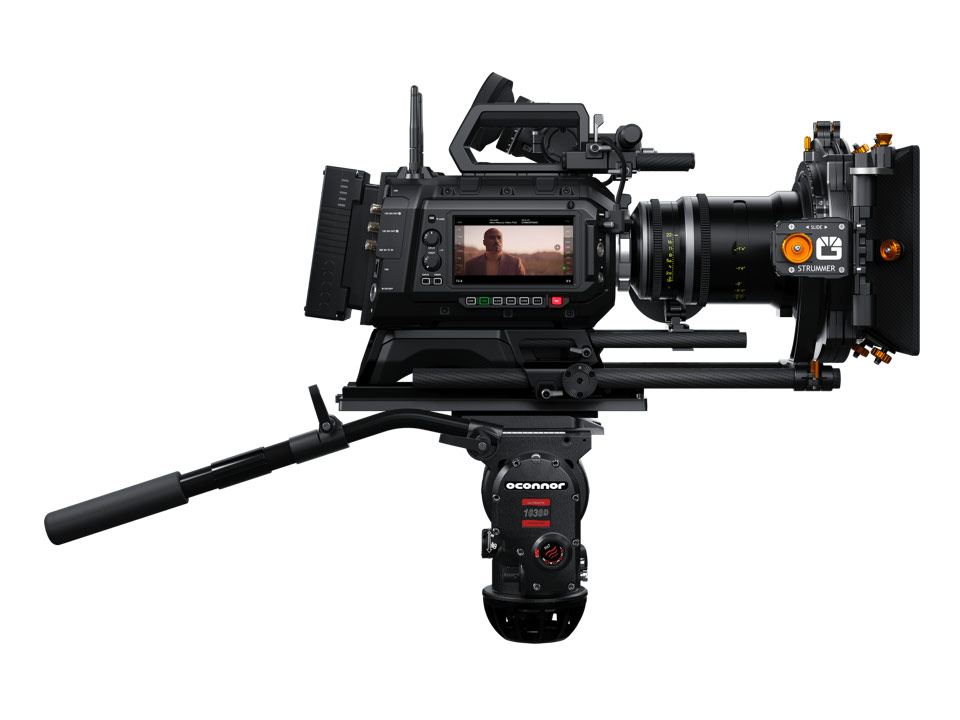
Blackmagic URSA Cine 12K LF Size and Build
This new Blackmagic URSA Cine 12K LF is slightly larger and heavier than Blackmagic’s original URSA Mini Pro 12K camera due to the added features and technology. Its body looks like an upgrade of the URSA Mini Pro body, but it has much-needed improvements in critical spots.
All the camera buttons are soft-touch and backlit. There are two top-mounted USB-C connections, the two antennae I mentioned earlier.
The Blackmagic URSA Cine 12K LF looks more like a professional camera with all the information a team may need in the right places. In the front, one will find a 7-pin LEMO connector and a 3-pin RS connector. Both are meant for lens accessories like powering a follow-focus motor with record run/stop, the 7-pin also adds serial control. The URSA Cine EVF is powered by a USB-C connection, which I think is better than a dedicated SDI. But, the biggest obvious feature of the Blackmagic URSA Cine 12K LF build is the larger assistant’s monitor on the right side of the camera.
Two Monitors
Let’s start with the right-side monitor. Users can access the great Blackmagic OS and UI via this monitor, but its best use is revealed when one accesses the new Lens Page on the user interface. One can add the lens data like, focus and aperture settings, helping a camera assistant pull focus or make any changes to the camera. These settings can be sent out the 12G SDI connections or seen in the other monitor and EVF. This screen may have a brightness of around 1500 nits, and I bet it’ll have a similar angle of view as screens found on the Pocket Cinema Camera 6K Pro / Blackmagic Cinema Camera 6K.
For the monitor on the camera’s left side or operator’s side, we get a flip-out mini monitor similar to the ones found on Blackmagic’s URSA Mini Pro models, but it can flip the screen 180 degrees and fold back flush with the body.
New EVF
The Blackmagic URSA Cine 12K LF will ship in one of its configurations with an URSA Cine EVF. However, this is different from the viewfinder Blackmagic built in the past. As one can see, this viewfinder has a new tool-less rob mounting system, allowing one to place the EVF in more positions than previous EVFs. Additionally, one may use the optional extension rod with the EVF allowing for EVF access when the camera is on a dolly. A dedicated USB-C powers this EVF found on the front of the camera.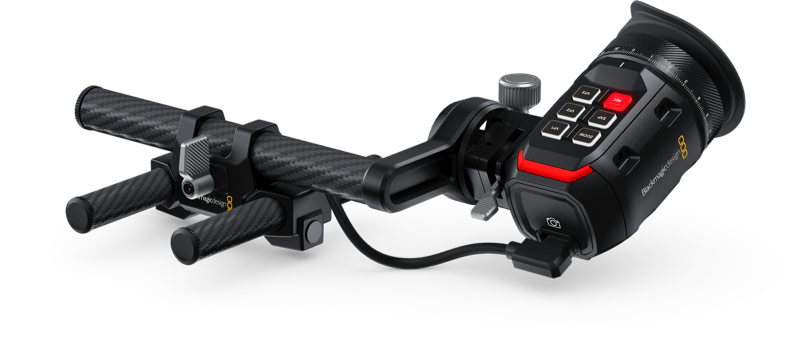
The new EVF has three camera function buttons on the top as well as a dedicated zoom button for checking focus, EXP button for checking false color or zebras, and a record button. These function buttons, and even the record button, are programmable and will allow users to access the camera’s UI and make the necessary changes without removing one’s eye from the EVF. To me, that means one can make changes on the fly when shooting hand-held.
Audio
Same is the placement for the XLR inputs on the Blackmagic URSA Cine 12K LF as in previous URSA Mini Pro models. Yet, we have dedicated and physical audio knobs on the right side of the camera. The right-side location for the audio controls is a great location as it allows a sound recordist to adjust the audio levels without getting in the way of an operator. We get two channels of audio with or without phantom power turned on.
Power
The Blackmagic URSA Cine 12K LF has a B-mount battery plate with 2-pin Lemo on the top for 12v power out and an 8-pin 24v 250W power supply similar to the one found on the Arri Alexa Mini. The camera can be powered by Gold Mount and V-mount batteries, but those less powerful batteries may not support the full 12K at 80fps power needs that the Blackmagic URSA Cine 12K LF may need. A 12K full-frame camera is a power-hungry camera.
Accessories
The new body for the Blackmagic URSA Cine 12K LF means new accessories but, good news, those accessories like a production baseplate and top handle come with the camera. As does the new rod based EVF in the larger of the two kits. I would not expect ones old URSA Mini Pro accessories working on the Blackmagic URSA Cine 12K LF.
Blackmagic URSA Cine 12K LF Price
The Blackmagic URSA Cine 12K LF will be priced at around $15,000 and will ship in a few months.

Filmtools
Filmmakers go-to destination for pre-production, production & post production equipment!
Shop Now












